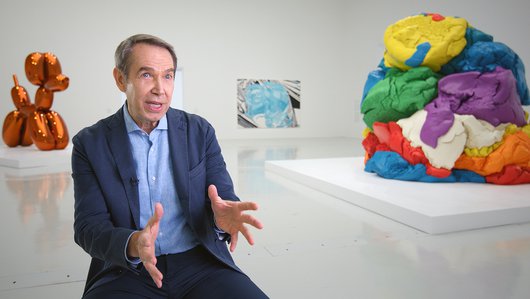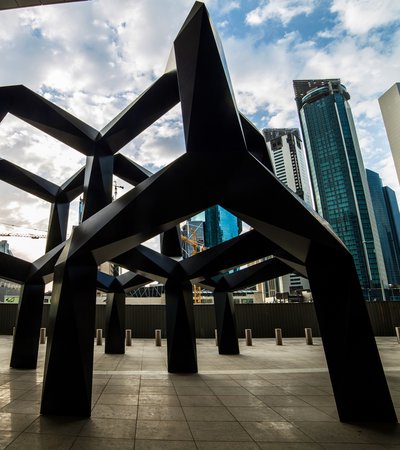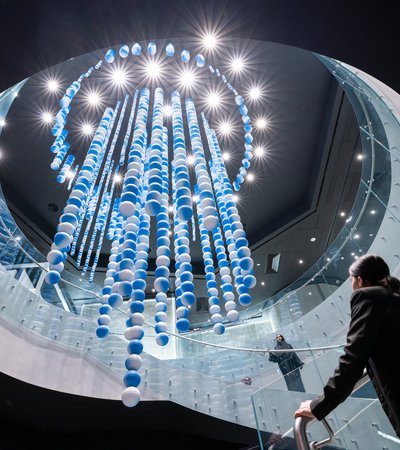Lost in America presents a portrait of American culture as seen through Koons’ autobiography, beginning with his childhood in suburban Pennsylvania. The exhibition features more than sixty artworks drawn from Koons’ four-decades-long career and is divided into 16 galleries, each introduced by the artist, emphasising his memories, influences and fascination with American visual culture. Conceived as an expansive self-portrait, Lost in America also includes sculptures and paintings with mesmerising, mirrored surfaces that reflect the viewers and call attention to notions of self-transformation and becoming.
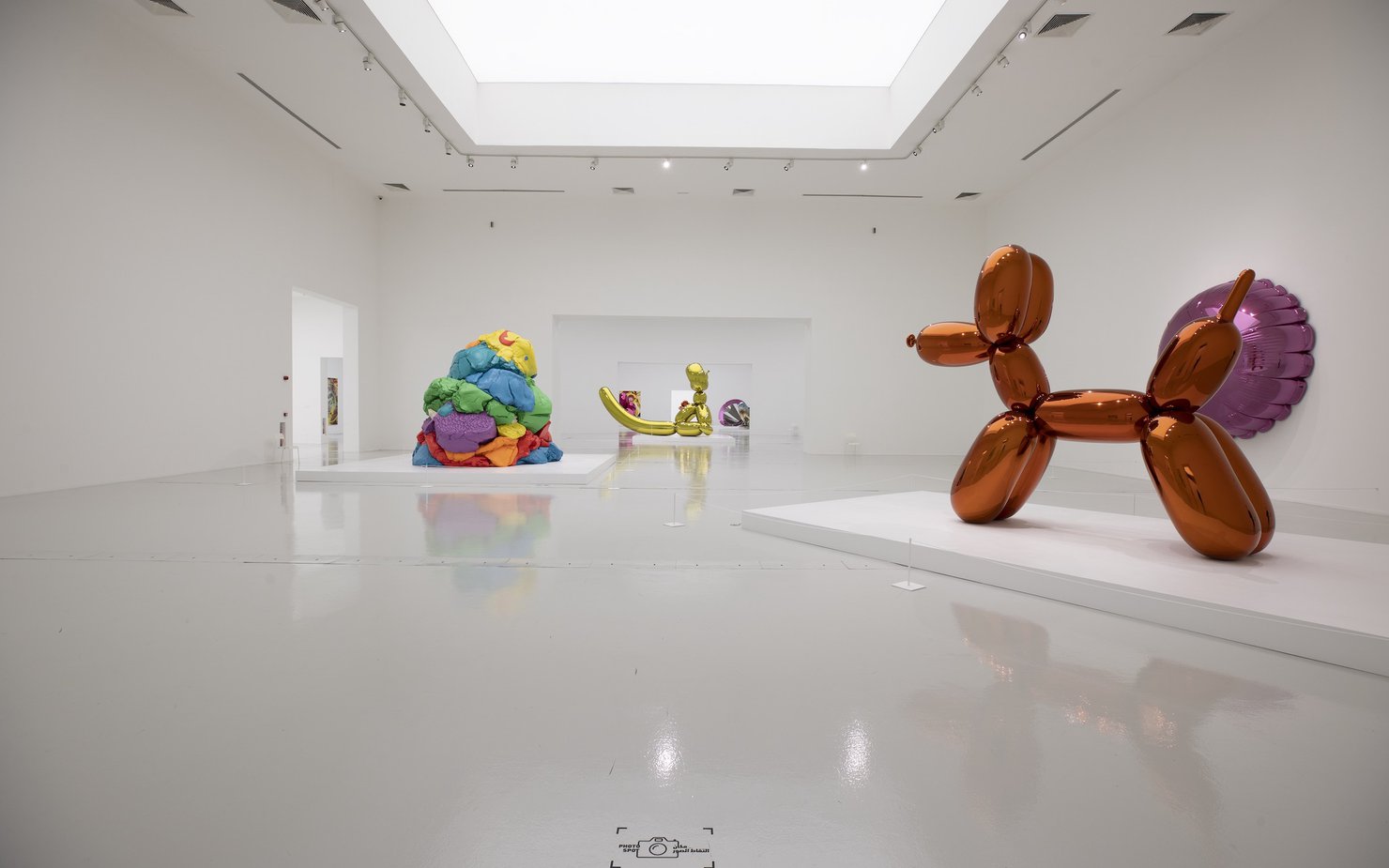
Jeff Koons: Lost in America
Past Exhibition
Curated by Massimiliano Gioni, the exhibition provides a unique view into the exceptional career of one of the world’s best-known contemporary artists, whose work bridges Pop, Minimalism and the readymade. This is Koons’ first exhibition in the Gulf region.
Some of the artist’s best-known work are represented from series such as The New (1980–87), Banality (1988), Celebration (1994–), Popeye (2002–13) and Antiquity (2008–), alongside more recent works that are shown for the first time during this special exhibition. In Koons’ paintings and sculptures, including some of the artist’s most iconic pieces such as Rabbit (1986), Balloon Dog (Orange) (1994–2000) and Play-Doh (1994–2014), everyday objects and industrial materials are transformed into engaging artworks that pose questions about desire and hope, the self and transcendence, individuality and the masses.
Throughout his career, Jeff Koons has radically transformed the world of art, forging new relationships between the avant-garde and mass culture, while developing new paradigms for the role of the artist in the age of hyper-communication. He shares a preoccupation with American popular culture with many of his predecessors, who include artists such as Roy Lichtenstein and Andy Warhol, and with peers such as Robert Gober, Barbara Kruger, Richard Prince, Charles Ray and Cindy Sherman.

Jeff Koons, Balloon Dog (Orange), 1994–2000, Mirror-polished stainless steel with transparent colour coating, 307.3 x 363.2 x 114.3 cm, one of five unique versions, The Mugrabi Collection. © Jeff Koons. Courtesy Mnuchin Gallery, New York. Photo: Tom Powel Imaging.
The following gallery texts were written by Jeff Koons to introduce and accompany the works on view.
The New
I have always been an artist. I’ve been an artist since I was born. Art has always been a way for me to define my own parameters, to externalise myself. The New Jeff Koons is based on my kindergarten photo. I am there with my crayons. This was at a time when I really felt that art had come in under my feet and was just taking me away, and I was following it. For me, being an artist was all about developing a sense of newness and individuality. One of the greatest pleasures I remember as a child was looking at a cereal box. It’s a visceral experience at that age because of the milk. You’ve been weaned off your mother, and you’re eating cereal with milk, and visually you can’t get tired of the box. I mean, you sit there, and you look at the front, and you look at the back. Then, maybe the next day, you pull out that box again, and you’re just still amazed by the packaging; you never tire of the amazement. It’s just about being able to find amazement in things.
People, every day, are confronted by images and products that are packaged. It puts individuals under great stress to feel packaged themselves. I always desire to be able to give the viewers a sense of themselves being packaged, to whatever level they’re looking for, just to instil a sense of self-confidence, self-worth. For The New, I was interested in the concepts of newness and immortality. In this series, I transformed brand new Hoover vacuum cleaners by placing them in lit Plexiglass cases in order to display them as though they were forever new and immortal. There is definitely this sense of being confronted by the object and having to ask yourself if the object will survive and outlive you, whether its integrity is stronger than yours. My work is very involved with the tragedy of unachievable states of being. It has always pursued perfection, which is unachievable; nevertheless, it has continued in its tragic quest.
Equilibrium
My family always showed me a lot of love. And art was always a reward system for me. My father had a furniture store in York, Pennsylvania, and was known as the best decorator there, somebody who was sensitive and had aesthetics. I grew up at a very early age learning that the environment can manipulate your emotions and the way that you feel. I would go into my father’s store, and one week, one room would be a kitchen and the adjoining room would be a living room. I would return the next week and the kitchen had become a den for people to watch television and the other room had become a bedroom. I would feel totally different emotions entering that space. I was being manipulated and I liked it. In that store, I grew up around objects just displaying themselves—a lamp, a little china dish, a chair. I think my involvement with the readymade comes from looking at objects, ashtrays, things in his showroom and just picking up on their voices. From my father’s store I learned a sense of static, a sense of order—that you could control your environment.
In the Equilibrium series, the fish tanks with the basketballs are all about control. They display an ultimate state of being—a kind of philosophical state of equilibrium. This ultimate or desired state is not sustainable though—eventually the ball will sink to the bottom of the tank. The Nike posters, which I have described as ‘Sirens’, represent people who had attained a certain status, a certain idea of achievement, perhaps another state of equilibrium: people who proclaim, ‘I have done it.’ These images lure viewers in, trying to convince them to participate in a specific idea of success. Then, there are the tools for equilibrium—the Aqua-lung, the snorkel, the lifeboat—all made in bronze, capable of weighing one’s aspirations down. Equilibrium is utopia, with all forces being equal. There is a sense of narrative in Equilibrium, a connectivity of things: I am interested in amplifying objects, capturing an intensity, a life energy.
Objects of Desire
When I’m working with objects, I try to reveal a certain aspect of their personality. To give you an example: if you place a shy person in a large crowd, his or her shyness will be revealed and enhanced. I work with objects in a very similar manner. I place them in a context or present them in a material that will enhance a specific personality trait within the objects themselves. I also try to capture the individual’s desire in the object, and to fix that person’s aspirations on the surface, in a condition of immortality. All of this is to say, in the system I was brought up in—the Western, capitalist system—one receives objects as rewards for labour and achievement. Once these objects have been accumulated, they work as support mechanisms for the individual: to define the personality of the self, to fulfil and express desire.
Personally, I don’t seek to make consumer icons, but to decode why and how consumer objects are glorified. My objects reflect desire, they don’t absorb it. For these sculptures, I thought stainless steel would be a wonderful material. I could polish it, and I could create a fake luxury. I never wanted real luxury, instead I wanted proletarian luxury, something visually intoxicating and disorienting. The surface of stainless steel is very much a false front for an underlying degradation.
Works like Train or Pail are non-functional, even when they utilise functional objects. These containers were originally made out of plastic and porcelain. I cast them in stainless steel, polished them and took them back to the original manufacturer, where they cleaned them and applied the tax stamp seal. It’s almost as though no one ever touched them because they are again things in themselves, their integrity is preserved. If you break the seal, you destroy the interface to the soul of the work. I’m neither trying to create an original, nor appropriate the original; these objects are now charged things.
Rabbit
Growing up in Pennsylvania, the sculpture of William Penn on the top of Philadelphia City Hall had a very big impact on me: just its presence, the way it connected to the past and history, and the kind of awe a sculpture could generate. It made me feel tied to history, tied to my community. I think it changed my life. To view the sculpture, you have to go all the way up the tower on the top of City Hall, and the whole journey up is like being inside a Jules Verne novel. The lantern on top is like a vehicle that takes you to the centre of the Earth or to the Moon. With the Statuary series, I started to think more explicitly about this kind of awe and desire that different objects can inspire.
In Statuary, I continued working with stainless steel. Polished objects have often been displayed by the church and by wealthy people to set a stage for both material security and enlightenment of spiritual nature; the stainless steel is a reflection of that stage. Its mirror-like quality reinforces a sense of intimacy and passiveness one may feel, say, in a public square with a fountain or with a sculpture.
Statuary presents a panoramic view of society: on one side there is Rabbit, and on the other side there is the neoclassical bust, Italian Woman, but almost any symbol can be used. This is because sculptures like Rabbit are chameleons. They could be read as so many other things and are being presented out of context. You can look at Rabbit and think of Easter and symbols of innocence, or of mischief. You can look at it and the carrot could be like a microphone and you could think of an orator, somebody making proclamations, a politician, maybe. This type of chameleon quality is what works need to be archetypal, because they have to change and transform and meet the needs of the viewer.
Banality
In York, Pennsylvania, there was a house built in the shape of a shoe. It was constructed in the 1940s by a local shoe salesman, and as a child I would always pass the gate. That house had always intrigued me, and I had an interest in this fantasy shelter. I like roadside attractions and how they use images to invite you in Even to this day, it’s very hard for me to go to Los Angeles without coming home with about three dozen donuts from Randy’s Donuts to share with my kids because of the large donut on top of the shop.
I believe very much in desire. I don’t really think in terms of high and low culture. I don’t believe in kitsch. I don’t even like that word because it implies looking down on something or someone. I believe in optimism and in liking things.
When I was working on Banality, I realised that as a society, we love these images, like the Shoe House, but at the same time, we have a hard time embracing them, accepting them and admitting that we feel a connection to them. I’ve tried to make work that any viewer, no matter where they come from, would have to respond to. If they cannot do that, it would only be because they have been told they are not supposed to like it. Banality is based on accepting one’s own taste, one’s own experience; your history, your past and your desires. Once you realise that everything is around you, the world just becomes abundant with possibilities. I try not to use this material in any cynical manner. I use it to penetrate mass consciousness—to communicate to people. For me, this is a sign of being baptised in the mainstream—to be baptised in banality.
Ethereal-Easyfun/Easyfun
My first important experience with another artist’s work was with Salvador Dalí. I was given a Dalí coffee table book by my parents one Christmas with a gold reflective surface and The Persistence of Memory on the cover. While I was in college, I had heard that he was staying at the St. Regis Hotel in New York, so I called and asked to speak to him. They put me through and he said, ‘I’m here—come and visit me.’
Probably, he was just being polite. I arranged to go on a Saturday morning, and he told me he would meet me in the lobby, and when I arrived, sure enough, Dalí was standing there. He was dressed in a fur coat and a tie with diamond pins; he treated every moment of life as special. We went to his exhibition at Knoedler Gallery, and he posed in front of his wonderful painting of the hallucinogenic royal tiger, and he swirled his moustache up for the photograph. I still have the photograph, of course.
What I like about Dalí is his interest in everydy life and everyday objects, and in the power of transcendence through material things—this journey of going inward. Personally, I don’t like it when things become just about the self. I always try to find a balance between the personal and the mass. My work deals with the psychology of myself and of the audience. Surrealism is very important to me as this kind of springboard.
My Easyfun-Ethereal paintings are very layered. I think that working with collage elements is a bit like working with readymade objects. I like to use pre-existing images instead of new images purely created in some emotional way. With Easyfun and Easyfun-Ethereal, there is a sense of things being familiar: whether it is an image of advertising meats or a lipstick, viewers really feel like they’re looking at themselves. This functions like a mirror. People feel a sense of themselves.
Popeye
Popeye, as a cartoon, is a symbol of the beginning of the 20th century. He makes me think about my father and my father’s generation. I became drawn to his image in a very intuitive way. I wanted to have a dialogue with art history and with Pop Art, and a dialogue with technology and its passage in time. I also wanted to deal with the notion of self-acceptance. One of the lines that Popeye is known for is ‘I yam what I yam.’ For me, he is a figure who has his limitations, but there’s something optimistic about that. He goes back and forth: he’s winning, no, he’s losing, no, he’s on top again, and he’s going to take care of this problem and there’s going to be a happy ending.
An artist has to have an anchor in personal iconography. You need it, it gives you a sense of traction, a base to hold on to, a vocabulary to speak from. It’s like one’s cultural history. But at the same time, mass iconography is a higher calling.
Popeye shows that to transcend to objective art, you have to first accept yourself. I'm for the return of the objective, and for the artist to regain the responsibility for manipulation and persuasion: for art to have as much political impact as the entertainment, film, pop music and advertising industries. What I’ve always loved about the Pop vocabulary is its generosity to the viewer. And I say ‘generosity to the viewer’ because Pop Art is very much about accepting the world around you, and making you feel that you are perfect the way you are, no matter what your background is, what your tastes are. It is the great equaliser. In the end, these images from mass culture are just metaphors for people, for the acceptance of others, and for the acceptance of things outside the self.
Hulk Elvis
Dictator is an exact recreation of a cannon that terrorised people during the Civil War—as exacting a replica as I could possibly make. When the Dictator was being used during the 19th century it would shoot off a 13-inch cannon ball and make a horrendous noise. It was the loudest weapon during the Civil War, and it was designed just to keep everybody up all night. For the Hulk Elvis series, I wanted to make a body of work that deals with the rational and irrational aspects of power, and to illustrate this I wanted to have two poles against each other: the Dictator on one side, and the Liberty Bell on the other. The dictator and the liberator. The Hulk, an action figure from an American comic book, has a powerful sense of energy, too. He is a protector that at the same time is capable of bringing the house down.
To me, the production of Dictator was a moral exercise in recreating something. You can’t recreate the original cannon authentically. You can’t cast it with the same chemicals. But morally, I tried to make as authentic a recreation as possible. With its heightened sense of history, the Dictator is a collective—or nostalgic—readymade. It’s almost like the actual object itself isn’t quite as enlightened as the involvement of all the other people who have come into confrontation with it over a period of time. These are mass objects, images that are part of our history, where the authorship isn't so important—the object or the image is very important, but the actual authorship of the image isn't the main element. To me, the readymade philosophy is about everything being accessible and there being no sense of ownership when it comes to human history. Everything’s already there.
Antiquity
Paleolithic sculptures like the Venus of Willendorf or the Venus of Lespugue are among my favourite artworks. I like their shape and how they could be held in your hand. These objects had a sense of importance in their community. They are very archetypal. They help us survive because they are figures of abundance. When I make my work, I never consciously sit down and think about creating a certain type of icon. I just listen to myself, and I try to bring forth archetypal images. That’s all that I try to do, to make something that is charged, that you feel physically, that you feel intellectually, that you feel in your senses. Balloon Venus was inspired by the Venus of Willendorf, and because of that, there’s an almost ritualistic element to the object.
In my Antiquity series, I’m not trying to put layers of history around the works so that somebody could only understand it if they opened up an art history book or looked at the timeline of civilisation. Instead, I am interested in what happens internally to the viewer through the layering of images. I think art is informative, and it develops a vocabulary that gets vaster and vaster. It’s not that each vocabulary stands alone. Once I was able to touch upon art history, I came to love this sense of connection. Coming to an understanding of the humanities, of aesthetics and the environment, and bringing those things together, you begin to imagine your possibilities. You feel a shift of intensity; you transform. I like to think of art history as putting a needle through kernels of popcorn and stringing them together.
Gazing Ball
I remember being fascinated by gazing balls in people's yards around where I grew up. Reflecting in 360 degrees, the gazing ball affirms your existence, and it affirms location, a specific place. Gazing balls are reflective and there’s a kind of generosity to that. People in my hometown would put them in front of their houses so that whoever drove by could look at them and have this experience of visual intensity. They evoke a sense of community in that way. Your neighbour doesn’t have to do that, but they do it for you. At the same time, I think gazing balls are tied to European history. I can look at them and I can think of the Renaissance, of Machiavelli and Leonardo da Vinci. And I can also think of Dalí, and, before that, I can think of the whole Christian tradition—all these types of references. Their reflection deals with identity, but also excitement, affirmation and the possibility of going into a higher state.
When I work with gazing balls as a medium, I am able to take it much further, to travel from the senses to the internal, to thought and feeling. For the Gazing Ball pieces, we cast sculptures and created exact replicas of paintings from different museums in Paris, Berlin and Munich, on which I then nestle the gazing balls. I’ve been interested in spectatorship for a while, and in particular in the idea of the ‘beholder’s share’, a concept that’s owed to Austrian art historian Alois Riegl. Approximately, it means that when artists paint a painting or produce a sculpture, their work isn’t finished before a spectator, or an audience reacts to it. This experience is about you, your desires, your interests, your participation, your relationship with this image. In Gazing Ball, you get a heightening of the senses, an affirmation of yourself, and, since the works themselves are reflected, they, too, become affirmed.
Ballerinas
I remember my grandparents always kept a little knickknack on a table in their television room: it was a porcelain ashtray in the shape of a figurine, and if you put a cigarette on it, the heat would make its body move. As a kid, I was mesmerised. I could look at it for hours, and it gave me a pleasure and a sense of excitement that I still try to find when I look at objects today. My fascination with porcelain probably comes from that little figurine. Personally, I don’t see any difference between the excitement that somebody can have from interacting with that type of object, and the sense of possibility and faith in the future that someone can find just looking at a great Rubens or a great Fragonard. When I think of this ashtray, I’m dealing with my own personal history, but when I bring images into the gallery space, I am also trying to give the viewers a sense of their own cultural histories, their own memories, whatever they may be.
In my ballerina sculptures, I am dealing with familiar images, whether through legend or the everyday, and playing with the idea of the past and present. When I choose an object, I am specifically choosing it to be able to show some aspect of what it is. I always try to make work that will help people survive that first moment of seeing things so that when they come into contact with art, it will be about their own history, their own potential.
Celebration
When I started making the Celebration series, it was a very trying time for me. So I began making these archetypal childhood images. I wanted the work to be upbeat, joyous, youthful and have these rich colours within the material itself.
I remember visiting with my son one time and bringing him some Play-Doh. We were playing on a little coffee table in the living room and he goes, ‘Look! Voilà!’ and showed me a mound where he had this colour piled on top of this colour, and that colour on top of that. It was just a mound of Play-Doh, but he was so proud, and it was so beautiful.
It showed everything I believe in about not making judgements. Children like blue for blue, pink for pink, and green for green. They like everything. I'm looking for an art that gives me the same feeling of trust that I had with art and colour when I was, say, four or five.
Balloon Dog and Moon are like balloons that a clown would make at a child’s birthday party, but of course, their scale is much bigger than any real balloon. I think the reason for choosing balloons is that it reverses the whole idea of the self. In our bodies, there’s a sense of internal density: there’s blood, guts, lungs—there is some depth internally. But if you look at a balloon, all of a sudden everything gets inverted: the inside is empty and now the external world all of a sudden has some depth to it. There’s a certain sense of security that people have in viewing an inflatable object like that, because this void outside them, this vastness, this empty space starts to have some depth to it. The inflatables’ exteriors are also totally reflective, and this constantly reminds the viewers of their existence. To me, Celebration is about the viewers—what their own dreams and memories are. It’s about using the public as a readymade.
I don’t think about Celebration as being specifically about childhood. I think that the series is comprised of ageless images. A child looking at it could be engaged. But there are things that are hopefully important to people in general. The works are dealing with aspects which people can think back to about their own childhood and to memory. I wanted the whole body of work to have that openness to the world; to the potential we have; to express an aspect of the profound. Art, for me, has always been a vehicle. Something that I’ve always been able to get lost in, something I’ve been able to create a reality out of and lean on during difficult times. I’m an optimist, and I want Celebration to make people feel optimistic about themselves. But to be an optimist, you always have to have a little bit of the other side. In everything you have to have some aspect of the other. If you’re going to communicate optimism, you have to have some aspect of pessimism, or you can’t give a full parameter of your emotions. I hope that my work has the truthfulness of Disney. I mean, in Disney you have complete optimism, but at the same time you have the Wicked Witch with the apple.
Many of the pieces in the series are just like big toys. Party Hat, for example, is my son’s party hat, but it also functions as a symbol of a cyclical year and of celebrating one’s birthday. You look at it and think of your child’s birthday or even your own birthday, or you remember the circus that came to town when you were a child, which you enjoyed so much.
Heavenly Bodies
I am very interested in icons, and Masaccio’s Expulsion from Paradise is one of the greatest icons in the world. It has had a tremendous influence on my work since I went to see it in Florence. The fresco dates from the early 15th century and is pervaded by a sense of guilt and shame. It is psychologically so interesting to me because the characters in the painting appear to be desperate because of their shame. I wanted to make a body of work that would stress the importance of removing those feelings of guilt and shame. My work from the early 1990s is all about trying to overcome shame and accept one’s own history and past as they are, without fears and without prejudice, without embarrassment. These works are about loving one’s own tastes and cultural origins. The flowers are meant to embolden people to accept their own pasts—to show beauty in simple things lets people come to terms with their own history. This work is about the things that distance people from embracing who they are, embracing their being.
With my work, I want to have a big impact on people’s lives. I want to communicate to as wide a mass as possible. In Europe, in the 17th century, the church had used the Baroque to attract and persuade the masses, and in return it has given the public a spiritual experience. I believe artists must exploit themselves and take responsibility to exploit their viewers. Many of my works use the Baroque to show that we are in the realm of the spiritual, the eternal. With my work, there is this sense of having one’s needs met with all this opulence. One can feel secure, taken care of and have a transcendent experience.
Balloon Monkey
Before I made Balloon Monkey, I acquired a 1920 issue of the Dadaist magazine Cannibale on the cover of which Francis Picabia had published his painting with the monkey affixed to it. The artwork (as illustrated below), shows a monkey with its tail stuck between its legs. I have always thought of it as a piece about mortality; a piece with a brute, physical tension. There is a kind of chaotic quality to Picabia’s work, like the sense of conflicting forces and technologies at work against each other. Personally, I have always liked to make works that make people feel at ease, not physically intimidated. At the same time, I guess I try to make things that are disarming, and there are moments when something humorous or curious or banal occurs. Images of monkeys are kind of approachable, but they’re also symbols of mortality, which can be disarming, too. The symbol is kind of open so that people can stop and spend more time reflecting.
Picabia’s painting is also the portrait of an artist, as the title suggests: it’s the portrait of Cézanne, Renoir and Rembrandt. I’ve always interpreted the piece to mean that all artists are a little bit like monkeys. They are just kind of fooling themselves if they think they’re doing anything. Certainly when I was a younger artist I wanted to show people that I aspired to bring my abilities to fruition, whatever they were. Now, for me, the only limitation is the self, and what the self can bring to the table, and that's really what I'm excited about.
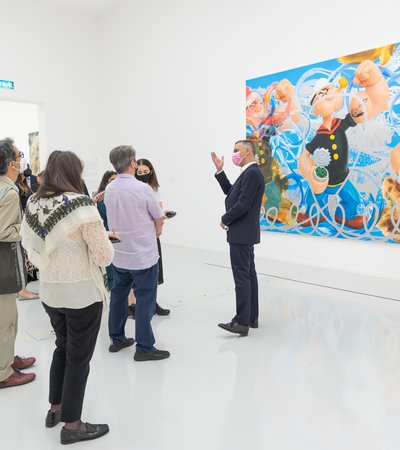
Jeff Koons: Art, Audience and Controversy

Jeff Koons: In His Own Words
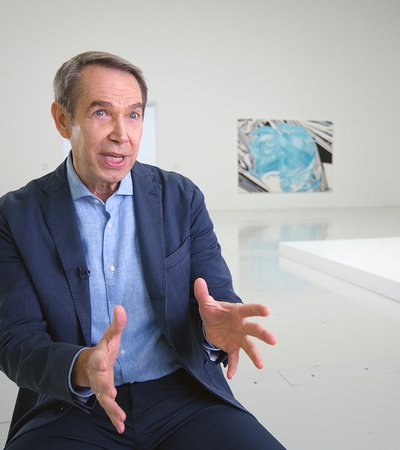
Jeff Koons' Hallucinatory Portrait of America
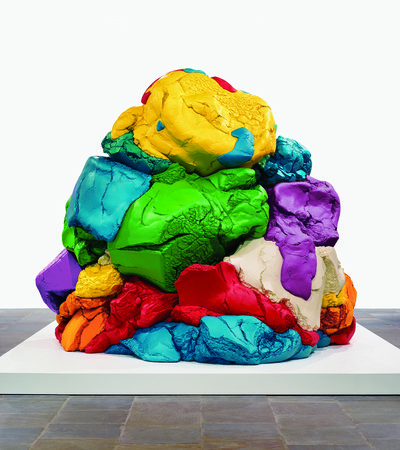
Curator Tour of Jeff Koons: Lost in America
